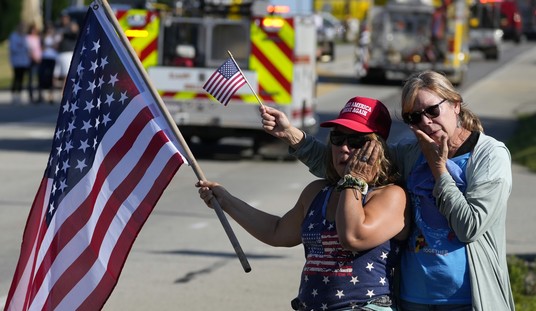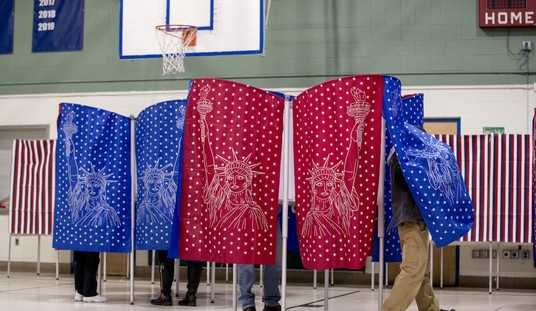The Hillary Clinton 2016 speculation began a while ago. Time is on topic this week with Clinton’s leg and black pump on the cover.
Over at Slate, Amanda Hess finds this cause for concern.
Clinton’s presumptive bid to become the first female president does position her as a powerhouse poised to stomp through the patriarchal status quo. But when publications like Time frame that feminist pursuit with images of women in pointy heels that leave feminized male “victims” in their wake, they undermine the female politician’s power even as they attempt to acknowledge it.
I surmise that these female domination images are acceptable when talking about flailing men—The Munk Debates used a similar image for “The End of Men”—but counterproductive stereotyping when talking about actual powerful women. Why?
Hess doesn’t state the mechanics of how such images undermine female power. I will. Women who found their power on breaking the glass ceiling cannot allow dominance imagery because they assume that they cannot withstand an attack, open or stealth, that they are against men. They assume they must engage in passive aggressive argument to win votes, which is ill-served by heel-grinding imagery. It’s also a tacit admission that women cannot dominate men without their consent.
Contrast the powerful who simply happen to be women, in the tradition of Margaret Thatcher and Golda Meir. They draw lines on intellectual issues, conservative vs progressive, diplomacy vs military engagement, nationalism vs federalism. They might see their sex used in political satire, but it doesn’t implicate their argument for seeking power. They are trying to lead, not break a glass ceiling, and so their gender is merely a distinguishing characteristic like Lincoln’s stovetop hat, Teddy Roosevelt’s hunting prowess, or Reagan’s B-actor status. As Peggy Noonan explained in her “Sex and the Sissy” article back in 2008 when the Clinton campaign complained about the Hillary nutcrackers,
If Golda Meir, a woman of not only proclaimed but actual toughness, heard about Golda nutcrackers, she would have bought them by the case and given them away as party favors.
Opponents must deal with women like Meir on the merits of their arguments, because those women can easily co-opt the sexist stuff.
Next: A few other head scratching passages from Hess’s analysis:
Hillary Clinton has again made the cover of Time magazine. This time, instead of appearing in typical human form, she is presented as a photo illustration Frankenstein’s monster[.]
Frankenstein’s monster? The only thing monster like about the image is the giant stature. But Frankenstein’s monster wasn’t a giant. I see a tenuous connection to the iconic monster as the cover depicts a body part and Frankenstein made his creation out of corpse parts. Otherwise, the allusion is imprecise and melodramatic.
Clinton is not exactly required to “run” for president like lesser candidates; she appears to be strolling casually into the nomination, trampling her potential competition with ease. (Though, side note: We thought that last time, too.)
Yes, they did. Maybe the elitist attitude that puts quotes around the term run and allows non-ironic use of “lesser candidates” had something to do with failures past?
As psychologist Helen Friedman told Salon in a story about macrophilia in 1999, the fetish often appears so gendered because “We live in a patriarchal culture … Women already see men as larger and more powerful. They don’t need to fantasize it.”
How would one square that analysis with rape fantasies and the resurgence of BDSM fantasies by women? Just one sliver of current circumstantial evidence suggesting that women fantasize about male power and domination more than the reverse: even laden with dreadful prose, Fifty Shades of Gray made fortune for the author, spawned one of the funnier Saturday Night Live skits in a while, and is currently in production starring Hollywood royalty. The only giant woman imagery that comes close in popularity is Brienne of Tarth in A Song of Ice and Fire. There are a few love story fan fictions about she and Jamie Lannister and a bit of commentary about the lack realistic female warriors (a frustration I share), but nothing about giant women dominating men.
As Jessica Valenti and The Cut have cataloged, stock-photo searches for “feminist” and “businesswoman” regularly turn up images that look indistinguishable from the Time cover[.]
Yes, the heel imagery is cliche. The imagery analysis isn’t original, either. Not only does every article I’ve seen reach for the same Valenti and The Cut studies, but also both writers studied stock images–not actual published images, but ones created in the hopes they would get used. That is, the images are intentionally generic. (Bonus points to Valenti for clever titling to suggest the images were from a FoxNews databank, not her suggestions for FoxNews. And, while I clicked though The Cut’s stock image slide show of boxing glove wearing, cliff scaling, and heel stomping women in sexy business attire, an ad for Moda Operandi featuring girlish women in flowery dresses captioned “All you need is love…and the dress” kept popping up. That made for amusing contrast.)
I offer the next in good faith, although I know that feminists have long grown tired of links to Camille Paglia, but as it happens, she published an analysis on stilettos just a few months ago. She covered the design and artistic origins of the pointy heel as well as it’s symbolism in culture, film, art, and fashion. She could undoubtedly provide fresh perspective for anyone interested.
*****
image via gameofthrones.wikia.com












Join the conversation as a VIP Member